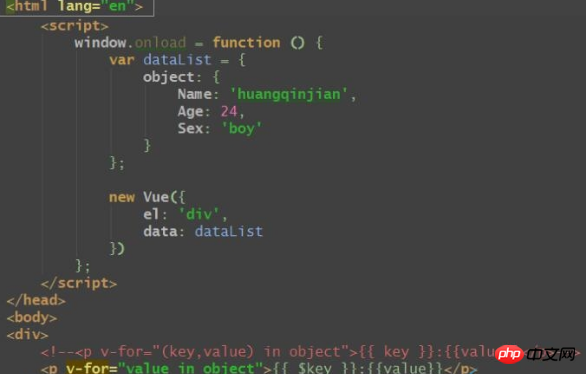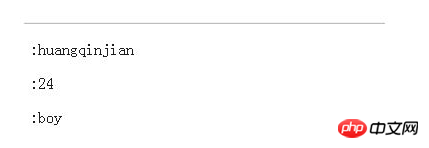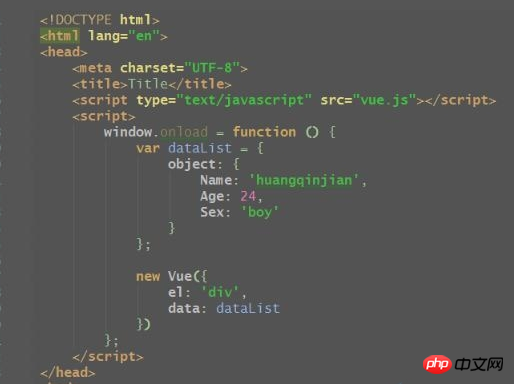Detailed graphic explanation of v-for iteration syntax in Vue2.0
This time I will bring you a detailed explanation of the use of v-for iteration syntax in Vue2.0. Notes on the use of v-for iteration syntax in Vue2.0are Which ones, the following are practical cases, let’s take a look.
Today, while writing code about Vue2.0, I found that the value $key could not be rendered successfully. The problem is as follows:

As a result, the key value of this object cannot be displayed:

Later, I checked the documentation and found out that this is because in Vue2.0, the v-for iteration syntax has changed:
Discarded:

NewArraySyntax
value in arr (value, index) in arr
New object syntax
value in obj (value, key) in obj (value, key, index) in obj
After solution:

I believe you have mastered the method after reading the case in this article. For more exciting information, please pay attention to other related articles on the php Chinese website!
Recommended reading:
How to realize the two-way binding of Vue2 parent component and child component
Solved in the vue project The problem of background image error due to incorrect path
The above is the detailed content of Detailed graphic explanation of v-for iteration syntax in Vue2.0. For more information, please follow other related articles on the PHP Chinese website!

Hot AI Tools

Undresser.AI Undress
AI-powered app for creating realistic nude photos

AI Clothes Remover
Online AI tool for removing clothes from photos.

Undress AI Tool
Undress images for free

Clothoff.io
AI clothes remover

Video Face Swap
Swap faces in any video effortlessly with our completely free AI face swap tool!

Hot Article

Hot Tools

Notepad++7.3.1
Easy-to-use and free code editor

SublimeText3 Chinese version
Chinese version, very easy to use

Zend Studio 13.0.1
Powerful PHP integrated development environment

Dreamweaver CS6
Visual web development tools

SublimeText3 Mac version
God-level code editing software (SublimeText3)

Hot Topics
 How to quickly turn your Python code into an API
Apr 14, 2023 pm 06:28 PM
How to quickly turn your Python code into an API
Apr 14, 2023 pm 06:28 PM
When it comes to API development, you may think of DjangoRESTFramework, Flask, and FastAPI. Yes, they can be used to write APIs. However, the framework shared today allows you to convert existing functions into APIs faster. It is Sanic . Introduction to Sanic Sanic[1] is a Python3.7+ web server and web framework designed to improve performance. It allows the use of the async/await syntax added in Python 3.5, which can effectively avoid blocking and improve response speed. Sanic is committed to providing a simple and fast way to create and launch
 Detailed explanation of v-for function in Vue3: perfect solution to list data rendering
Jun 18, 2023 am 09:57 AM
Detailed explanation of v-for function in Vue3: perfect solution to list data rendering
Jun 18, 2023 am 09:57 AM
With the continuous advancement of digital technology, front-end development has become an increasingly popular profession. Vue3 has become the first choice of more and more developers due to its simplicity, ease of use, efficiency and stability. Among them, the v-for function is one of the core functions used for list data rendering in Vue3. In this article, we will provide a detailed explanation of the v-for function in Vue3, so that you can better use it to solve actual development problems. 1. Basic syntax The basic syntax of the v-for function is as follows: <divv-
 Best practices and performance optimization methods for using v-for in Vue
Jul 17, 2023 am 08:53 AM
Best practices and performance optimization methods for using v-for in Vue
Jul 17, 2023 am 08:53 AM
Best practices and performance optimization methods for using v-for in Vue Introduction: In Vue development, it is very common to use the v-for instruction, which can conveniently traverse and render the data of an array or object onto the template. However, improper use of v-for may cause performance issues when dealing with large-scale data. This article will introduce the best practices when using the v-for directive and provide some performance optimization methods. Best practice: When using the v-for instruction in Vue to render each item of data using a unique Key value, you need to
 Tips for using v-for to implement dynamic sorting in Vue
Jun 25, 2023 am 09:18 AM
Tips for using v-for to implement dynamic sorting in Vue
Jun 25, 2023 am 09:18 AM
Vue is a modern JavaScript framework that helps us build dynamic web pages and complex applications easily. In Vue, you can easily create loop structures using v-for to iteratively render data. In some specific scenarios, we can also use v-for to implement dynamic sorting. This article will introduce how to use v-for to implement dynamic sorting techniques in Vue, as well as some application scenarios and examples. 1. Use v-for to make it simple
![How to solve '[Vue warn]: v-for='item in items': item' error](https://img.php.cn/upload/article/000/000/164/169241709258603.jpg?x-oss-process=image/resize,m_fill,h_207,w_330) How to solve '[Vue warn]: v-for='item in items': item' error
Aug 19, 2023 am 11:51 AM
How to solve '[Vue warn]: v-for='item in items': item' error
Aug 19, 2023 am 11:51 AM
How to solve the "[Vuewarn]:v-for="iteminiitems":item" error During the Vue development process, using the v-for directive for list rendering is a very common requirement. However, sometimes we may encounter an error: "[Vuewarn]:v-for="iteminiitems":item". This article will introduce the cause and solution of this error, and give some code examples. First, let’s understand
 What are the syntax and structure characteristics of lambda expressions?
Apr 25, 2024 pm 01:12 PM
What are the syntax and structure characteristics of lambda expressions?
Apr 25, 2024 pm 01:12 PM
Lambda expression is an anonymous function without a name, and its syntax is: (parameter_list)->expression. They feature anonymity, diversity, currying, and closure. In practical applications, Lambda expressions can be used to define functions concisely, such as the summation function sum_lambda=lambdax,y:x+y, and apply the map() function to the list to perform the summation operation.
 New type alias syntax in PHP8.0
May 14, 2023 pm 02:21 PM
New type alias syntax in PHP8.0
May 14, 2023 pm 02:21 PM
With the release of PHP 8.0, a new type alias syntax has been added, making it easier to use custom types. In this article, we'll take a closer look at this new syntax and its impact on developers. What is a type alias? In PHP, a type alias is essentially a variable that references the name of another type. This variable can be used like any other type and declared anywhere in the code. The main function of this syntax is to define custom aliases for commonly used types, making the code easier to read and understand.
 Which one has higher priority, v-if or v-for in vue?
Jul 20, 2022 pm 06:02 PM
Which one has higher priority, v-if or v-for in vue?
Jul 20, 2022 pm 06:02 PM
In vue2, v-for has a higher priority than v-if; in vue3, v-if has a higher priority than v-for. In vue, never use v-if and v-for on the same element at the same time, which will cause a waste of performance (each rendering will loop first and then perform conditional judgment); if you want to avoid this situation, Templates can be nested in the outer layer (page rendering does not generate DOM nodes), v-if judgment is performed at this layer, and then v-for loop is performed internally.






